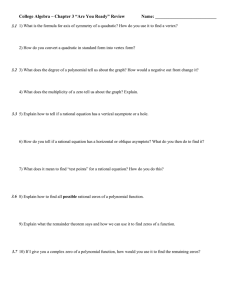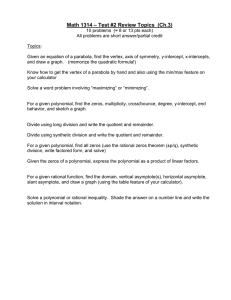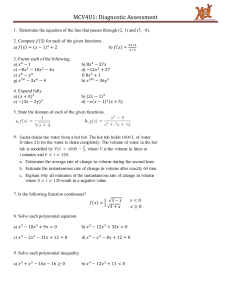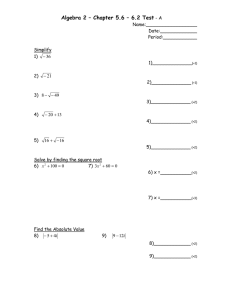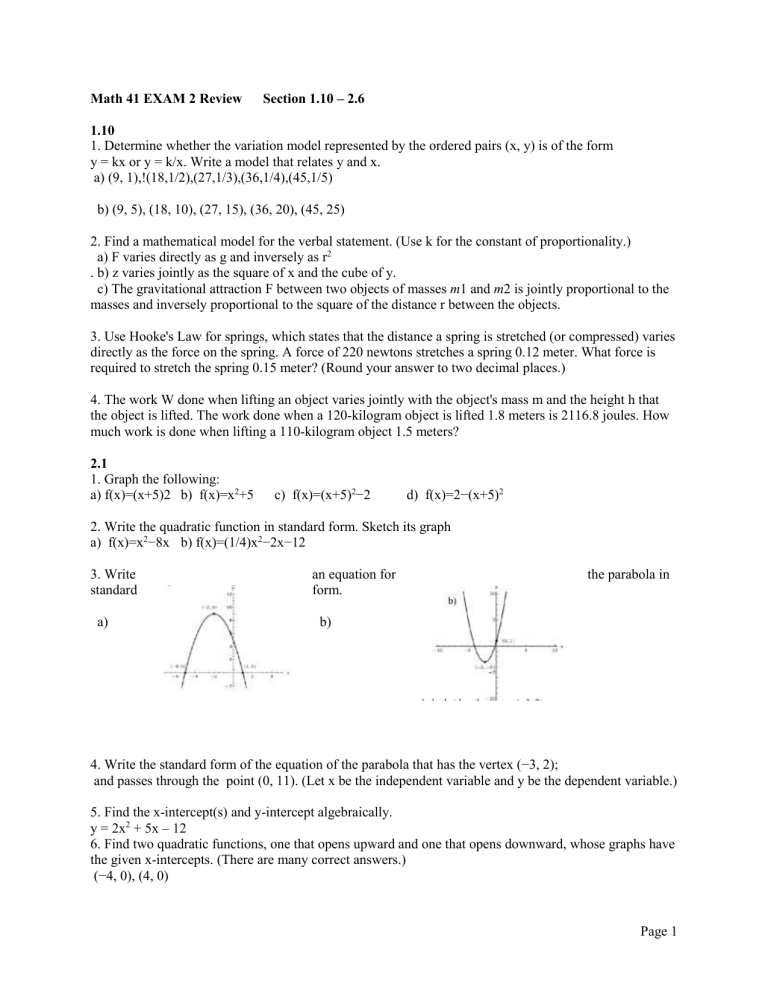
Math 41 EXAM 2 Review Section 1.10 – 2.6 1.10 1. Determine whether the variation model represented by the ordered pairs (x, y) is of the form y = kx or y = k/x. Write a model that relates y and x. a) (9, 1),!(18,1/2),(27,1/3),(36,1/4),(45,1/5) b) (9, 5), (18, 10), (27, 15), (36, 20), (45, 25) 2. Find a mathematical model for the verbal statement. (Use k for the constant of proportionality.) a) F varies directly as g and inversely as r2 . b) z varies jointly as the square of x and the cube of y. c) The gravitational attraction F between two objects of masses m1 and m2 is jointly proportional to the masses and inversely proportional to the square of the distance r between the objects. 3. Use Hooke's Law for springs, which states that the distance a spring is stretched (or compressed) varies directly as the force on the spring. A force of 220 newtons stretches a spring 0.12 meter. What force is required to stretch the spring 0.15 meter? (Round your answer to two decimal places.) 4. The work W done when lifting an object varies jointly with the object's mass m and the height h that the object is lifted. The work done when a 120-kilogram object is lifted 1.8 meters is 2116.8 joules. How much work is done when lifting a 110-kilogram object 1.5 meters? 2.1 1. Graph the following: a) f(x)=(x+5)2 b) f(x)=x2+5 c) f(x)=(x+5)2−2 d) f(x)=2−(x+5)2 2. Write the quadratic function in standard form. Sketch its graph a) f(x)=x2−8x b) f(x)=(1/4)x2−2x−12 3. Write standard a) an equation for form. the parabola in b) 4. Write the standard form of the equation of the parabola that has the vertex (−3, 2); and passes through the point (0, 11). (Let x be the independent variable and y be the dependent variable.) 5. Find the x-intercept(s) and y-intercept algebraically. y = 2x2 + 5x – 12 6. Find two quadratic functions, one that opens upward and one that opens downward, whose graphs have the given x-intercepts. (There are many correct answers.) (−4, 0), (4, 0) Page 1 7. Find two positive real numbers whose product is a maximum. The sum of the first and twice the second is 36. 8. A rancher has 300 feet of fencing to enclose two adjacent rectangular corrals (see figure). a) Write the area A of the corrals as a function of x. b) Find the dimensions that will produce the maximum enclosed area. 2.2 Study webassign #1 - #8 to know the basic concepts and terminology of polynomials Webassign #9 - #14: Match y = f(x) with its graph without calculator 1. Describe the right-hand and left-hand behavior of the graph of the polynomial function. a) h(x)=3−x5 b) f(x)=−3.7x5+x3−5 c) g(x)=3.7x7+x3−5x2+8 d) k(x)=7x6+x3−5x2+8 2. Given g(t) = t5 − 10t3 + 25t a) Find all real zeros of the polynomial function. (Enter your answers as a comma-separated list. If there is no s b) Determine the multiplicity of each zero. c) Determine the maximum possible number of turning points of the graph of the function. 3. Given f(x) = x4 − x3 − 20x2 a) Find all real zeros of the polynomial function. (Enter your answers as a comma-separated list. If there is no s b) Determine the multiplicity of each zero. c) Determine the maximum possible number of turning points of the graph of the function. 4. Find a polynomial function that has the given zeros. (There are many correct answers.) a) 0, 1, 90 b) 4, -6, 6, 0 c) 4, 6+√3, 6 −√3 5. Find a polynomial of degree n that has only the given zero(s). (There are many correct answers.) x = −7, 1, 9; n = 4 6. A roofing contractor is fabricating gutters from 12-inch aluminum sheeting. The contractor plans to use an aluminum siding folding press to create the gutter by creasing equal lengths for the sidewalls (see figure). (a) Let x represent the height of the sidewall of the gutter. Write a function A that represents the cross-sectional area of the gutter. (b) The length of the aluminum sheeting is 18 feet. Write a function V that represents the volume of one run of gutter in terms of x. (c) Determine the domain of the function V. (Enter your answer using interval notation.) 2.3 Page 2 Study terms and facts of Webassign #1 - #5. 1. Use long division to divide. (Simplify your answer completely.) a) (2x3 − 3x2 − 18x + 5) ÷ (2x + 5) , x ≠ − 5/2 b) (x3 − 6) ÷ (x2 + 1) 2. Use synthetic division to divide. (Simplify your answer completely.) a) (3x3 − 4x + 21x2 − 28) ÷ (x + 7), x ≠ −7 b) −3x4 /x+2n , x ≠ −2 3. Write the function in the form f(x)=(x−k)q(x)+r for the given value of k. f(x) = x3 − 5x2 − 13x + 8, k = −2 a) f(x) = b) f(-2) = 4. Use the Remainder Theorem and synthetic division to find each function value. Verify your answers using another method. g(x) = 2x6 + 3x4 − x2 + 4 a) g(2) b) g(-1) 5. Use synthetic division to show that x is a solution of the third-degree polynomial equation, and use the result to factor the polynomial completely. List all the real solutions of the equation. (Enter your answers as a comma-separated list.) x3 − 37x − 84 = 0, x = −4 2.4 1. Write the complex number in standard form. a) 2− √−80 b) −14i+i2c) (– 4+7i) + (– 4 – 7i) 2. Perform the operation and write the result in standard form. a) ( 3 +√17i)( 3 −√17i) b) (– 4+7i)(– 4 – 7i) c) 11/1−I 2.5 Study terms and facts of Webassign #1 - #6 1. Determine the number of zeros of the polynomial function. a) f(x) = x5 + 3x – 4 b) f(x) = x8 − x9 2. Use the Rational Zero Test to list the possible rational zeros of f. Verify that the zeros of f shown on the graph are contained in the list. f(x) = x3 + 2x2 − x – 2 b) f(x) = 2x4 − 21x3 + 49x2 + 9x − 63 3. Find all the rational zeros of the function. a) f(x) = x3 − 7x – 6 b) 2x3 + 3x2 – 1 c) h(x) = x3 − 14x2 + 53x − 40 4. Find all real solutions of the polynomial equation. z4 + z3 + z2 + 3z − 6 = 0 5. Consider the polynomial f(x) = x4 − 11x2 + 18 a) Use the Rational Zero Test to find two rational zeros. b) Factor the polynomial completely. 6. Find a polynomial function with real coefficients that has the zeros 7, 9 + i. (There are many correct answers.) Page 3 2. Use synthetic division to divide. (Simplify your answer completely.) a) (3x3 − 4x + 21x2 − 28) ÷ (x + 7), x ≠ −7 b) −3x4 / x+2, x ≠ −2 3. Write the function in the form f(x)=(x−k)q(x)+r for the given value of k. f(x) = x3 − 5x2 − 13x + 8, k = −2 a) f(x) = b) f(-2) = 4. Use the Remainder Theorem and synthetic division to find each function value. Verify your answers using another method. g(x) = 2x6 + 3x4 − x2 + 4 a) g(2) b) g(-1) 5. Use synthetic division to show that x is a solution of the third-degree polynomial equation, and use the result to factor the polynomial completely. List all the real solutions of the equation. (Enter your answers as a comma-separated list.) x3 − 37x − 84 = 0, x = −4 2.4 1. Write the complex number in standard form. a) 2− −√80 b) −14i+i2 c) (– 4+7i) + (– 4 – 7i) 2. Perform the operation and write the result in standard form. a) ( √3 +√17i)(√ 3 −√17i) b) (– 4+7i)(– 4 – 7i) c) 11/1−i 2.5 Study terms and facts of Webassign #1 - #6 1. Determine the number of zeros of the polynomial function. a) f(x) = x5 + 3x – 4 b) f(x) = x8 − x9 2. Use the Rational Zero Test to list the possible rational zeros of f. Verify that the zeros of f shown on the graph are contained in the list. f(x) = x3 + 2x2 − x – 2 b) f(x) = 2x4 − 21x3 + 49x2 + 9x − 63 3. Find all the rational zeros of the function. a) f(x) = x3 − 7x – 6 b) 2x3 + 3x2 – 1 c) h(x) = x3 − 14x2 + 53x − 40 4. Find all real solutions of the polynomial equation. z4 + z3 + z2 + 3z − 6 = 0 5. Consider the polynomial f(x) = x4 − 11x2 + 18 a) Use the Rational Zero Test to find two rational zeros. b) Factor the polynomial completely. 6. Find a polynomial function with real coefficients that has the zeros 7, 9 + i. (There are many correct answers.) Page 4 Page 5 7. Consider the polynomial f(x) = x4 + 6x2 − 27 (a) Write the polynomial as the product of factors that are irreducible over the rationals. (b) Write the polynomial as the product of linear and quadratic factors that are irreducible over the reals. (c) Write the polynomial in completely factored form. 8. If 4+3i is a zero of the function g(x) = x3 − 3x2 − 15x + 125. Find all zeros. 9. Write the polynomial as the product of linear factors. h(x) = x2 − 2x + 26 10. Use Descartes's Rule of Signs to determine the possible numbers of positive and negative real zeros of the function. a) g(x) = 2x3 − 3x2 – 7 b) h(x) = 3x3 + 2x2 + 2 11. Use synthetic division to verify the upper and lower bounds of the real zeros of f. f(x) = x3 + 3x2 − 2x + 3 (a) Upper: x = 1 (b) Lower: x = −5 2.6 1. Find the domain of the function. a) g(x)=3x /x(x+1) b) g(x)=3x2 /(x2−1) 2. Find all vertical and horizontal asymptotes of the graph of the function. a) f(x)=3+x/3−x b) f(x)=3+x /1−x2 c) f(x)=3+x2/3−x d) f(x)=3+6x2 /x2+1 3. Consider the rational function f(x)=x2−12x+35 /x2−81 a) Find the domain b) Find x-intercepts and y-intercept c) Find any vertical asymptote and horizontal asymptote d) Graph the function 4. Consider the rational function f(x)=x2−25 / x−5 a) Find the domain b) Find x-intercepts and y-intercept c) Find any vertical asymptote and horizontal asymptote d) Graph the function 5. Consider the rational function f(x)=x2−25 / x2−4x−5 a) Find the domain b) Find x-intercepts and y-intercept c) Find any vertical asymptote and horizontal asymptote d) Graph the function 6. Consider the rational function f(x)=x2 / x−3 a) Find the domain c) Find any vertical asymptote and slant b) Find x-intercepts and y-intercept d) Graph the function Page 6


